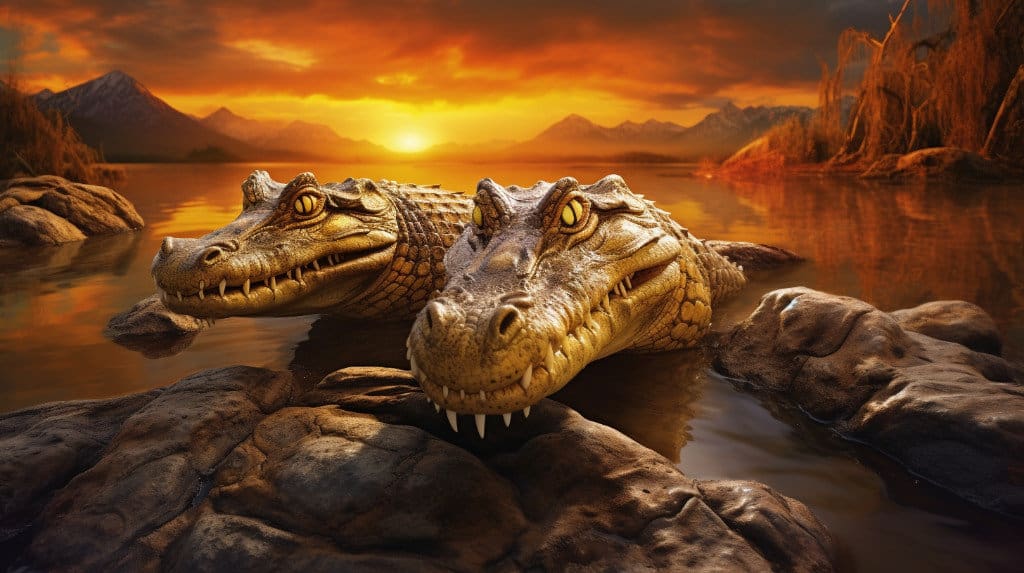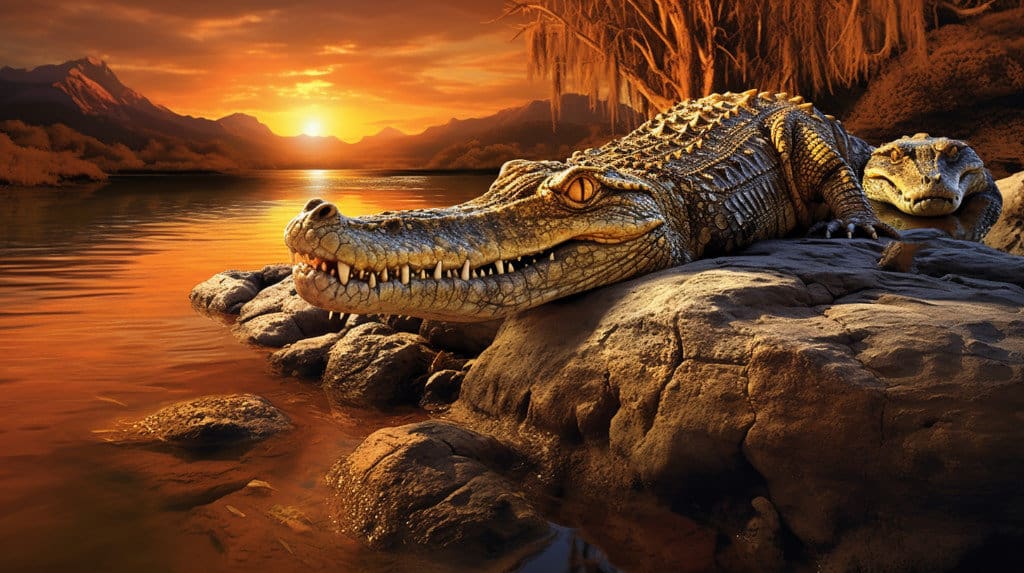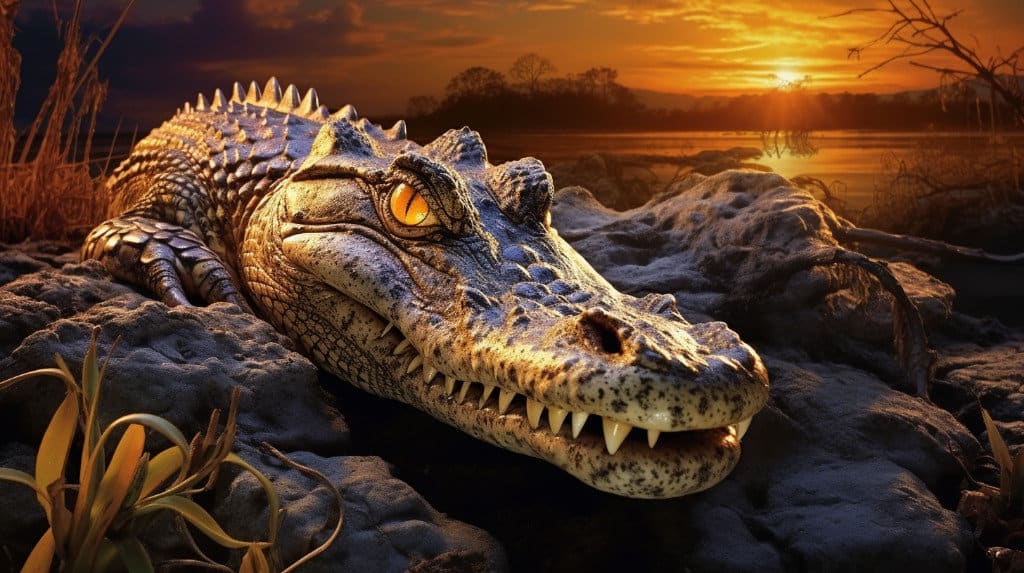A crocodile is indeed a reptile. Reptiles are a diverse group of cold-blooded animals that include snakes, lizards, turtles, and crocodiles. Crocodiles are large, aquatic reptiles that are well-known for their long snouts, powerful jaws, and armored bodies. They are found in tropical regions across the world and are known for their ability to live both in water and on land. With their sharp teeth and strong bite, crocodiles are formidable predators. They primarily feed on fish, birds, and mammals that come near the water‘s edge. Now, let’s take a look at some key takeaways about crocodiles in the table below:
Key Takeaways
| Fact | Description |
|---|---|
| Classification | Reptile |
| Habitat | Tropical regions |
| Physical Features | Long snouts, powerful jaws, armored bodies |
| Diet | Fish, birds, mammals |
| Behavior | Ambush predators, can live in water and on land |
| Conservation Status | Varies by species, some are endangered |
Understanding the Classification of Crocodiles

Crocodiles as Reptiles
Crocodiles are fascinating creatures that belong to the reptile classification. As reptiles, they share certain characteristics with other members of their taxonomic group. Reptiles are a diverse group of cold-blooded animals that have scaly skin and lay eggs. They are known for their ability to adapt to various habitats, including land, freshwater, and marine environments. Crocodiles, with their unique traits and adaptations, are a prime example of reptilian excellence.
When it comes to crocodile species, there are several different types that exist. Some of the most well-known species include the Nile crocodile, the American crocodile, and the saltwater crocodile. Each species has its own distinct characteristics and behaviors, but they all share common reptilian traits.
Crocodiles have a remarkable anatomy that allows them to thrive in their habitats. Their long, streamlined bodies are covered in tough, scaly skin that provides protection and helps regulate their body temperature. They have powerful jaws filled with sharp teeth, which they use to catch and devour their prey. Their eyes and nostrils are positioned on top of their heads, allowing them to remain mostly submerged in water while still being able to see and breathe.
Crocodiles: Not a Lizard
Although crocodiles may resemble lizards to some extent, they are not classified as lizards. Lizards belong to a different reptile family and have distinct characteristics that set them apart from crocodiles. While both crocodiles and lizards are reptiles, they have different evolutionary histories and adaptations.
One key difference between crocodiles and lizards is their habitat preference. Lizards are typically found in terrestrial environments, such as deserts, forests, and grasslands. They have adapted to life on land and are known for their agility and ability to climb. On the other hand, crocodiles are semi-aquatic creatures that spend a significant amount of time in water. They are well-suited for aquatic life, with their streamlined bodies and powerful tails that propel them through the water with ease.
Crocodiles: Not an Amphibian
Another common misconception is that crocodiles are amphibians. While both crocodiles and amphibians are cold-blooded animals, they belong to different taxonomic groups. Amphibians, such as frogs and salamanders, have a unique life cycle that involves metamorphosis from an aquatic larval stage to a terrestrial adult stage.
Crocodiles, on the other hand, do not undergo metamorphosis and remain in their reptilian form throughout their lives. They are born as miniature versions of their parents and grow steadily over time. Unlike amphibians, crocodiles do not have a larval stage and do not rely on water for their reproduction.
In conclusion, crocodiles are fascinating reptiles that have evolved to thrive in various habitats. They are not lizards or amphibians but belong to their own unique taxonomic group. Understanding the classification of crocodiles helps us appreciate their biology, behavior, and ecological significance in the natural world.
The Distinctive Characteristics of Crocodiles

Crocodiles are fascinating creatures with unique characteristics that set them apart from other reptiles. In this article, we will explore the physical features that make a crocodile a reptile, the habitat of crocodiles and why they are considered marine reptiles, and the impressive size that makes crocodiles the biggest reptiles.
Physical Features that Make a Crocodile a Reptile
Crocodiles possess several physical features that classify them as reptiles. These characteristics include:
Cold-blooded nature: Like all reptiles, crocodiles are cold-blooded animals. This means that their body temperature is regulated by the surrounding environment.
Scaly skin: Crocodiles have tough, scaly skin that provides protection and helps them retain moisture. These scales also aid in reducing friction when swimming.
Powerful jaws: Crocodiles are known for their incredibly strong jaws. They have sharp teeth designed for capturing and gripping their prey. Their bite force is one of the strongest in the animal kingdom.
Webbed feet: Crocodiles have webbed feet, which enable them to be excellent swimmers. Their feet are also equipped with sharp claws for gripping and maneuvering in water and on land.
The Habitat of Crocodiles: Why They are Considered Marine Reptiles
Crocodiles are often associated with freshwater habitats, but they are also considered marine reptiles due to their ability to adapt to saltwater environments. Here are some key points about their habitat:
Freshwater habitats: Crocodiles are commonly found in rivers, lakes, and swamps. They prefer warm tropical regions, where they can bask in the sun to regulate their body temperature.
Saltwater habitats: Some species of crocodiles, such as the saltwater crocodile, are capable of living in saltwater habitats. They can be found in coastal areas, estuaries, and even venture into the open ocean.
Adaptations to marine life: Crocodiles that inhabit saltwater environments have specialized salt glands that allow them to excrete excess salt from their bodies. This adaptation enables them to survive in brackish or fully saltwater habitats.
Crocodiles: The Biggest Reptiles?
Crocodiles are renowned for their impressive size, making them some of the largest reptiles on Earth. Here are some notable facts about their size:
Species variation: There are several species of crocodiles, and their size can vary significantly. The saltwater crocodile, for example, is the largest living reptile, with males reaching lengths of up to 6 meters (20 feet) or more.
Growth throughout life: Crocodiles exhibit indeterminate growth, meaning they continue to grow throughout their lives. While they may experience growth spurts during their early years, they can continue to grow at a slower rate as they age.
Impressive weight: Along with their length, crocodiles can also be incredibly heavy. The largest individuals can weigh over a ton, making them formidable predators in their ecosystems.
In conclusion, crocodiles possess distinctive characteristics that make them unique among reptiles. Their physical features, ability to adapt to different habitats, and impressive size contribute to their fascinating biology. Whether they are basking in the sun or lurking beneath the water‘s surface, crocodiles continue to captivate our curiosity and awe.
Keywords: Crocodile characteristics, reptile classification, types of reptiles, crocodile species, reptile traits, crocodile habitat, crocodile behavior, reptile family, crocodile biology, reptile species, alligator vs crocodile, cold-blooded animals, crocodile anatomy, reptile evolution, crocodile diet, reptilian characteristics, crocodile taxonomy, reptile ecology, crocodile lifespan, reptile habitats.
Comparing Crocodiles with Other Reptiles

Crocodiles are fascinating creatures that belong to the reptile family. They have unique characteristics that set them apart from other reptiles. In this article, we will explore the similarities and differences between crocodiles and other reptiles, such as alligators, as well as their predator-prey relationship with pythons.
Crocodiles vs Alligators: Similarities and Differences
Crocodiles and alligators are often confused due to their similar appearances. However, there are distinct differences between these two reptiles. Let’s take a closer look at their characteristics:
Crocodile Characteristics
Crocodiles are cold-blooded animals that have been around for millions of years. They are known for their long, powerful jaws filled with sharp teeth. With their muscular bodies and strong tails, crocodiles are excellent swimmers. They have a streamlined shape that allows them to move swiftly through water.
Alligator Traits
Alligators, on the other hand, have a broader snout compared to crocodiles. Their teeth are not as visible when their mouths are closed. Alligators are primarily found in freshwater habitats, while crocodiles can thrive in both freshwater and saltwater environments.
Alligator vs Crocodile
One of the key differences between alligators and crocodiles lies in their geographic distribution. Alligators are native to the United States and China, while crocodiles can be found in various parts of the world, including Africa, Australia, and the Americas. Additionally, crocodiles tend to be more aggressive than alligators, making them more formidable predators.
Crocodiles and Pythons: The Predator-Prey Relationship
Crocodiles have a complex predator-prey relationship with pythons, which are large constrictor snakes. While crocodiles are known for their powerful jaws, pythons rely on their strength and ability to constrict their prey. These two reptiles often encounter each other in their shared habitats.
Crocodiles are opportunistic predators and will feed on a variety of animals, including fish, birds, and mammals. Pythons, on the other hand, are ambush predators that rely on stealth to capture their prey. They have been known to prey on smaller crocodiles, taking advantage of their size and strength.
The interaction between crocodiles and pythons is a fascinating example of the predator-prey relationship in the reptile world. It showcases the diverse strategies and adaptations that reptiles have developed over time.
In conclusion, crocodiles possess unique traits and characteristics that distinguish them from other reptiles. Their relationship with other reptiles, such as alligators and pythons, further highlights the diversity and complexity of the reptile world. Whether it’s their anatomy, behavior, or ecological role, crocodiles continue to captivate our curiosity and admiration.
Different Types of Crocodiles and Their Classification
Crocodiles are fascinating reptiles that belong to the Crocodylidae family. They are known for their unique characteristics and are classified into different species based on their traits, habitat, and behavior. Let’s explore some of the most notable types of crocodiles and their classification.
The Saltwater Crocodile: A True Reptile
The Saltwater Crocodile, also known as Crocodylus porosus, is the largest living reptile on Earth. It is a true reptile, belonging to the order Crocodylia. These crocodiles are well-adapted to marine environments and are found in the brackish waters of Southeast Asia, Australia, and the Pacific Islands.
Crocodile Characteristics: – They have a powerful jaw and sharp teeth, making them formidable predators. – Saltwater crocodiles are known for their ability to swim long distances in saltwater. – They have a dark coloration, which helps them blend in with their surroundings. – These crocodiles have a unique gland in their tongue that allows them to excrete excess salt from their bodies.
Crocodile Habitat and Behavior: – Saltwater crocodiles inhabit a wide range of habitats, including rivers, estuaries, and coastal areas. – They are known for their aggressive behavior and are apex predators in their ecosystems. – These crocodiles are known to undertake long-distance migrations, often traveling hundreds of kilometers.
The Nile Crocodile: Another Reptile Species
The Nile Crocodile, scientifically known as Crocodylus niloticus, is a large reptile found in sub-Saharan Africa. It is one of the most well-known crocodile species and is closely related to the Saltwater Crocodile.
Crocodile Characteristics: – Nile crocodiles have a robust body and a long, powerful tail, which aids in swimming. – They have a broad snout and sharp teeth, adapted for catching and gripping prey. – These crocodiles have a rough, scaly skin that provides protection and helps regulate body temperature.
Crocodile Habitat and Behavior: – Nile crocodiles inhabit various aquatic habitats, including rivers, lakes, and swamps. – They are opportunistic predators and feed on a wide range of animals, including fish, birds, and mammals. – Nile crocodiles are known for their ability to remain motionless for long periods, waiting for unsuspecting prey to approach.
The Estuarine Crocodile: A Unique Reptile
The Estuarine Crocodile, also known as Crocodylus porosus, is another remarkable species of crocodile. It is found in the estuarine and coastal regions of Southeast Asia and Northern Australia.
Crocodile Characteristics: – Estuarine crocodiles are known for their massive size, with males reaching lengths of up to 6 meters. – They have a broad snout and large, powerful jaws, capable of exerting tremendous force. – These crocodiles have a unique feature called “salt glands” that allow them to tolerate high salinity levels.
Crocodile Habitat and Behavior: – Estuarine crocodiles inhabit a range of habitats, including rivers, estuaries, and mangrove swamps. – They are apex predators and have been known to attack and consume large prey, including water buffalo and sharks. – Estuarine crocodiles are highly territorial and will defend their territories aggressively.
In conclusion, crocodiles are a diverse group of reptiles with fascinating characteristics and behaviors. The Saltwater Crocodile, Nile Crocodile, and Estuarine Crocodile are just a few examples of the different types of crocodiles that exist in the world. Each species has its own unique traits and adaptations that allow them to thrive in their respective habitats.
Conclusion
In conclusion, a crocodile is indeed a reptile. Reptiles are a diverse group of cold-blooded animals that have scales, lay eggs, and breathe air. Crocodiles possess all of these characteristics, making them a part of the reptile family. They have a tough, scaly skin that helps protect them from their environment, and they lay eggs on land. Additionally, crocodiles are ectothermic, meaning they rely on external sources of heat to regulate their body temperature. With their long, powerful jaws and ability to live in both water and land, crocodiles are fascinating creatures that exemplify the characteristics of reptiles.
Frequently Asked Questions
1. Is a saltwater crocodile a lizard?
No, a saltwater crocodile is not a lizard. Although they both belong to the class Reptilia, they are in different families. Saltwater crocodiles are part of the Crocodylidae family, whereas lizards belong to various families within the order Squamata.
2. Are crocodiles reptiles?
Yes, crocodiles are reptiles. They belong to the order Crocodylia and the class Reptilia which also includes other animals such as lizards, snakes, and turtles.
3. What is a crocodile: reptile or amphibian?
A crocodile is a reptile, not an amphibian. Reptiles are cold-blooded vertebrates that lay hard-shelled eggs, unlike amphibians which lay their eggs in water.
4. Is a crocodile a big lizard?
No, a crocodile is not a big lizard. Although they are both reptiles, crocodiles and lizards are different species with distinct characteristics and belong to different families within the class Reptilia.
5. Why is a crocodile a reptile?
A crocodile is classified as a reptile because it shares common characteristics with this group, including being cold-blooded, having scaly skin, and laying eggs on land. Additionally, crocodiles have a particular heart structure and lung capacity that are unique to reptiles.
6. Is an alligator a reptile?
Yes, an alligator is a reptile. It belongs to the Alligatoridae family within the order Crocodylia and shares common characteristics with other reptiles, such as being cold-blooded and laying eggs on land.
7. What makes a crocodile a reptile?
Crocodiles are classified as reptiles due to their shared characteristics with this group, including being cold-blooded, possessing scaly skin, and laying eggs on land. They also have a specific heart structure and lung capacity that are unique to reptiles.
8. What is a crocodile lizard baby called?
A baby crocodile is often referred to as a hatchling. This term is used because crocodiles emerge from eggs that are hatched, similar to many other reptiles.
9. Are crocodiles the biggest reptiles?
Yes, the saltwater crocodile is currently the largest living reptile by mass and length. It can reach up to 7 meters in length and weigh up to 2,000 kilograms.
10. Can a crocodile kill a python?
Yes, a crocodile can kill a python. In their respective habitats, crocodiles are apex predators and can feed on a variety of prey, including snakes such as pythons. However, interactions between these two species are relatively rare.




